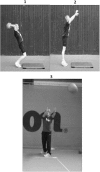Fitness testing of tennis players: how valuable is it?
- PMID: 24668375
- PMCID: PMC3995228
- DOI: 10.1136/bjsports-2013-093152
Fitness testing of tennis players: how valuable is it?
Abstract
In tennis, sport-specific technical skills are predominant factors, although a complex profile of physical performance factors is also required. The fitness test batteries assist in examining tennis players' capabilities for performance at different levels in the laboratory as well as in the field, in the junior or elite level. While laboratory tests can be, and are, used to evaluate basic performance characteristics of athletes in most individual sports, in a more specific approach, field-based methods are better suited to the demands of complex intermittent sports like tennis. A regular test battery performed at different periods of the year allows to obtain an individual's performance profile, as well as the ability to prescribe individual training interventions. Thus, the aim of the present review was to describe and evaluate the different physical tests recommended and used by practitioners, sports scientists and institutions (national tennis federations).
Keywords: Aerobic Fitness/Vo2 Max; Assessing Validity and Reliability of Test of Physiological Parameters; Evaluation; Strength Isometric Isokinetic.
Figures







References
-
- Fernandez-Fernandez J, Sanz-Rivas D, Mendez-Villanueva A. A review of the activity profile and physiological demands of tennis match play. Strength Cond J 2009;31:15–26 - PubMed
-
- Svensson M, Drust B. Testing soccer players. J Sports Sci 2005;23:601–18 - PubMed
-
- Reilly T, Morris T, Whyte G. The specificity of training prescription and physiological assessment: a review. J Sports Sci 2009;27:575–89 - PubMed
-
- MacDougall JD, Wenger HA, Green HJ. eds Physiological testing of the high-performance athlete. Champaign, IL: Human Kinetics Books, 1991
-
- Bangsbo J. The physiology of soccer with special reference to intense intermittent exercise. Acta Physiol Scand Suppl 1994;619:1. - PubMed
Publication types
MeSH terms
LinkOut - more resources
Full Text Sources
Other Literature Sources
Medical
